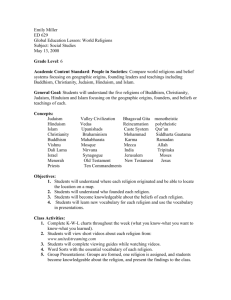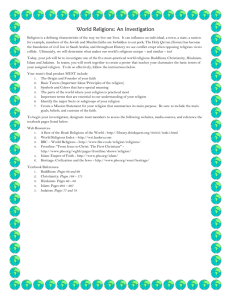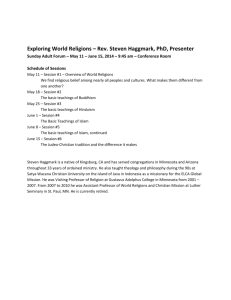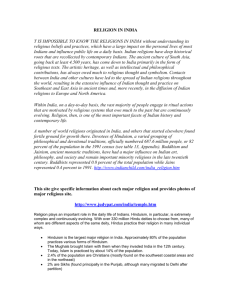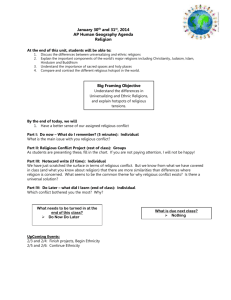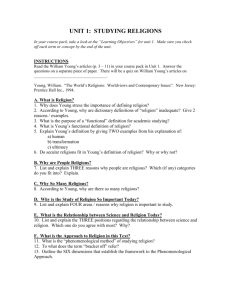Religion: Origins and Diffusion
advertisement
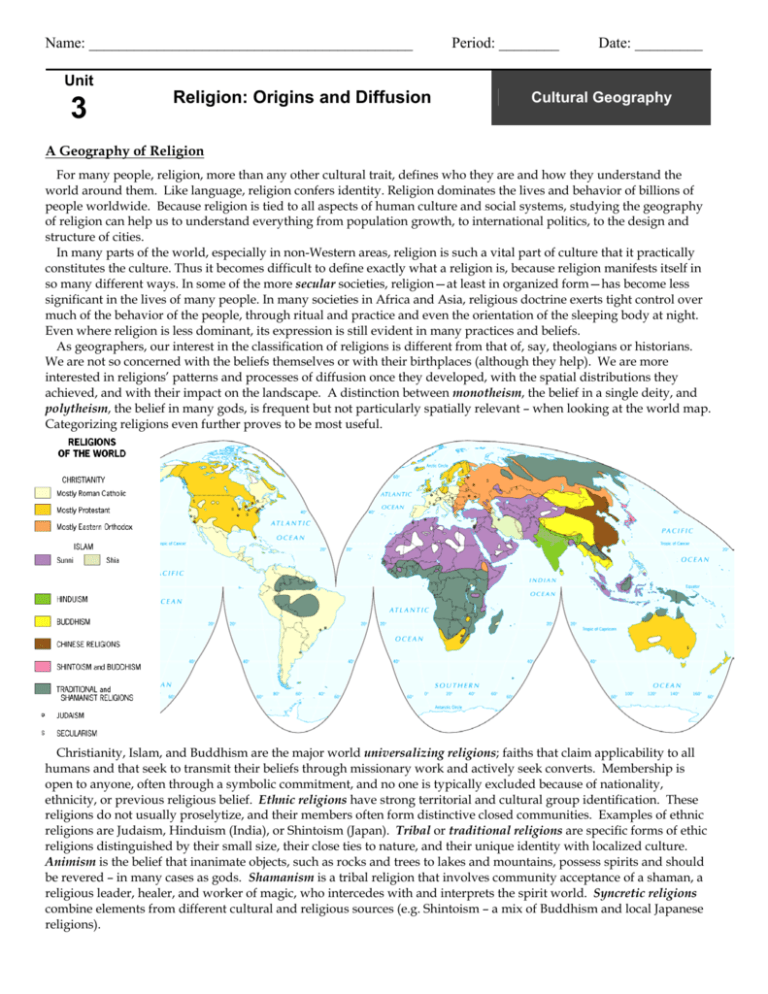
Name: ___________________________________________ Unit 3 Religion: Origins and Diffusion Period: ________ Date: _________ Cultural Geography A Geography of Religion For many people, religion, more than any other cultural trait, defines who they are and how they understand the world around them. Like language, religion confers identity. Religion dominates the lives and behavior of billions of people worldwide. Because religion is tied to all aspects of human culture and social systems, studying the geography of religion can help us to understand everything from population growth, to international politics, to the design and structure of cities. In many parts of the world, especially in non-Western areas, religion is such a vital part of culture that it practically constitutes the culture. Thus it becomes difficult to define exactly what a religion is, because religion manifests itself in so many different ways. In some of the more secular societies, religion—at least in organized form—has become less significant in the lives of many people. In many societies in Africa and Asia, religious doctrine exerts tight control over much of the behavior of the people, through ritual and practice and even the orientation of the sleeping body at night. Even where religion is less dominant, its expression is still evident in many practices and beliefs. As geographers, our interest in the classification of religions is different from that of, say, theologians or historians. We are not so concerned with the beliefs themselves or with their birthplaces (although they help). We are more interested in religions’ patterns and processes of diffusion once they developed, with the spatial distributions they achieved, and with their impact on the landscape. A distinction between monotheism, the belief in a single deity, and polytheism, the belief in many gods, is frequent but not particularly spatially relevant – when looking at the world map. Categorizing religions even further proves to be most useful. Christianity, Islam, and Buddhism are the major world universalizing religions; faiths that claim applicability to all humans and that seek to transmit their beliefs through missionary work and actively seek converts. Membership is open to anyone, often through a symbolic commitment, and no one is typically excluded because of nationality, ethnicity, or previous religious belief. Ethnic religions have strong territorial and cultural group identification. These religions do not usually proselytize, and their members often form distinctive closed communities. Examples of ethnic religions are Judaism, Hinduism (India), or Shintoism (Japan). Tribal or traditional religions are specific forms of ethic religions distinguished by their small size, their close ties to nature, and their unique identity with localized culture. Animism is the belief that inanimate objects, such as rocks and trees to lakes and mountains, possess spirits and should be revered – in many cases as gods. Shamanism is a tribal religion that involves community acceptance of a shaman, a religious leader, healer, and worker of magic, who intercedes with and interprets the spirit world. Syncretic religions combine elements from different cultural and religious sources (e.g. Shintoism – a mix of Buddhism and local Japanese religions). Religious Origins and Diffusion Hinduism is the oldest major religion originating around the Indus Valley (within modern day Pakistan) around 4,000 years ago. Hinduism diffused into Southeast Asia (mostly India) and into the island of Bali in Indonesia. There are more than 750 million followers today. Buddhism appeared in eastern India around the sixth century B.C., as a reaction to certain aspects of Hinduism (such as the caste system). It began diffusing around the third century B.C. into Nepal, and South and East Asia. There are around 350 million followers today. Christianity originated with the birth of Jesus near Jerusalem. It diffused rapidly (hierarchically) throughout Europe when the Roman Emperor Constantine was converted to Christianity in A.D. 312. It was diffused worldwide (relocation) through the European Age of colonialism beginning around the late 15th century. There are more than 1.5 billion followers today, more than any other religion. Islam, the youngest of the major world religions, arose out of the teachings of Muhammad, who was born in A.D. 571 around eastern Arabia. It spread from modern day Saudi Arabia mostly by hierarchical diffusion through Arab traders into Southwest Asia and North Africa. It has also spread eastward and dominates Indonesia (the largest Muslim nation today). There are more than 1.2 billion followers today, and is the fastest growing religion (in part due to the high growth rates of the regions in which it dominates). Hinduism Hinduism, an ethnic religion, has no founder, creed, all-encompassing written text, or single authority. Hindus do not separate religion from other aspects of life, for them it is an inextricable part of their existence. Its fundamental doctrine is karma, which deals with the transferability of the soul. The principle of reincarnation is a cornerstone of Hinduism; a soul moves upward or downward according to the individual’s behavior. For example, if you mistreat an animal in this life, chances are you will be that animal in a future life. The ideal is to move upward in the hierarchy (the untouchables are the lowest caste) and then to escape from the eternal cycle through union with the Brahman (a Hindu of the highest caste). The entire universe is part of the Divine, but it shows itself in many forms, which is The Hindu temple at Khajuraho, India why it is often considered to be polytheistic. The caste system, which is dominant in India, locks people into particular social classes, and imposes many restrictions on the lower castes. Since Hindu doctrines include the belief that constructing temples or shrines bestows merit on the builder, the cultural landscape is inundated with them. As a rule, temples should be in a “comfortable” position (typically under a large shady tree near water) for easy access for their gods – because many will not venture far from water. Thus the cultural landscape of Hinduism is the cultural landscape of India. Buddhism Buddhism has no unique creed, no single authority (god), and no single sacred book. It was founded by Prince Siddhartha, the heir to a wealthy kingdom of what is now Nepal. He was upset by the poverty caused by the Hindu castes. The Buddha (enlightened one) was the first prominent Indian religious leader to speak out against Hinduism’s caste system. When the Buddha received enlightenment he sat under the Bodhi (awakening) tree. He believed that enlightenment could be attained by anyone through knowledge. Buddhists believe that all life is “dukkha” (nothing permanent), and seek to achieve Shiva Temple, Rameshvaram, India nirvana (highest level of enlightenment). Buddhism spread through contagious diffusion through missionaries, monks, and merchants from eastern India into East and Southeast Asia. The cultural landscape That Phanom Shrine, Thailand contains pagodas and shrines that are often bell-shaped (to protect burial mounds); statues of the Buddha may also be seen (with the classic cross-legged pose). Christianity Christian Orthodox, the oldest established denomination (or branch), originated in the eastern part of the Roman Empire after its break up. Roman Catholicism developed after the papacy was established, which gave rise to the second branch in Rome. The power of the Church peaked during the Middle Ages. This branch still maintains the largest bureaucracy of all faiths, dominating much of Europe, as well as Central and South America. Catholicism began to weaken during the Reformation, beginning with the teachings of Martin Luther (with the tacking of the “95 Theses” on a German church in 1517) and John Calvin. The third major branch, therefore, came from the Protestant movement, which now dominates in parts of Northern Europe and North America. Jesus was a manifestation of God, whose teachings are found in the Gospels in the New Testament of the Bible. Christians believe in the entire Bible, including the Old Testament. Even though Christians believe in the Trinity (God, the Son, and the Holy Spirit), the three entities are considered one God, so it is monotheistic. Today Christianity is the largest and most widespread of the First Church of Christ, world religions, and has always been characterized by Connecticut, USA aggressive and persistent proselytism. Christian missionaries created an almost worldwide network of conversion through the colonial period. The cultural landscape (especially of Catholicism) has differed greatly over time. In Medieval Europe, the cathedral or church was the focus of life. They towered over the other buildings, which were clustered around them. For Protestants, the actual church didn’t have to be large or ornate, so these buildings tend to blend in to the local architecture. Nonetheless, the New England-spired church became a model for Protestant edifices elsewhere in the United States. One last interesting Notre Dame Cathedral, Paris, France fact is that Christians utilize more land for their dead than in any other religion with widespread use of cemeteries. Islam Islam – the word means “submission” (to the will of God) - is the youngest of the world’s four major religions. It springs from the same Judaic roots as Christianity and embodies some of the same beliefs – there is only one God; Adam was the first human; Abraham was one of his descendants. Mohammed believed he was the real and ultimate prophet and received a series of revelations from Allah, written in the Qur’an (Koran), their holy book. Observance of the “five pillars” of Islam and surrender to the will of Allah unite the faithful into a brotherhood with no concern over race, color, or caste. The five pillars include 1) repeated expressions of the basic creed, 2) frequent prayer (in the direction of Mecca – Muhammad’s birthplace), 3) a month of daytime fasting (Ramadan), 4) almsgiving, and 5) at least one pilgrimage to Mecca (Hajj). By the time of Mohammed’s death in A.D. 632, all of Arabia had joined Islam, and it spread quickly by contagious diffusion outward from that source region. The holiest places in the Islamic world are in Mecca, Medina (both in Saudi Arabia), and Jerusalem. The orthodox Sunnis represent the largest sect of Islam. Dome of the Rock, Jerusalem, Israel The Shiites (or Shiahs) represent around 13% of all Muslims and dominate in Iran and Iraq (to a lesser extent). Sunni Muslims believe in the effectiveness of family and community in solving life’s problems. Those who follow Shiism believe that imams, Muslim leaders regarded as sinless and infallible, are the sole sources of true knowledge. The cultural landscape of Islamic cities and towns are dominated by mosques (often with domes or spires), which are usually their most imposing and most carefully maintained buildings. The mosque symbolizes the power of the faith and its role in the community. Its primacy in the cultural landscape confirms the degree to which, in the Muslim world, religion and culture are one Judaism One of the oldest religions, Judaism (ethnic), emerged before 2,000 B.C. Its religious traditions lie in the teachings of Abraham, who united his people. Jewish history is filled with upheavals. Moses led the Israelites from Egypt into Canaan, where an internal conflict developed and the nation split into two branches - Israel and Judah. The Romans destroyed their capital, Jerusalem, around A.D. 70 and their scattering after this event is known as the Diaspora. Perhaps more than six million Jews were exterminated at the hands of the Nazis during the Holocaust. The Zionist goal of a homeland became a reality in 1948. There is no predominant design of their synagogues, or temples, but all have an ark containing the Five Books of Moses known as Wailing Wall, Jerusalem, Israel the Torah. The most symbolic landscape is the Western Wall at the edge of the temple mount in Jerusalem. The Jewish faith has about 18 million adherents, but the distribution of Jews proves that Judaism is indeed a world religion. Other Religions While Buddha’s teachings were gaining converts in India, Confucius (551-479 B.C.) and his followers constructed a blueprint for Chinese civilization. Confucianism focuses on 13 texts (Confucian Classics) that became the focus of Chinese education and society for 2,000 years. Taoism (“The Way Things Are”) may have come about through an older contemporary of Confucius, Lao-Tsu. Competition, possession, and even the pursuit of knowledge were to be avoided. These beliefs can help us understand why the Chinese, perhaps the most advanced civilization of its time, did not explore and dominate the world like the Europeans did. Shintoism (“The Way of the Gods”) sprang up in Japan around 500 B.C. It wasn’t until after WWII that religion and politics were separated in Japan, when the U.S. forced the emperor to renounce his divinity. Lastly, animist religions are centered on the worship of inanimate objects. These religions are most commonly found in the rural areas of South America, Sub-Saharan Africa, and the South Pacific.

